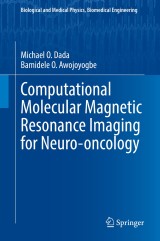Details

Computational Molecular Magnetic Resonance Imaging for Neuro-oncology
Biological and Medical Physics, Biomedical Engineering
|
139,09 € |
|
| Verlag: | Springer |
| Format: | |
| Veröffentl.: | 31.07.2021 |
| ISBN/EAN: | 9783030767280 |
| Sprache: | englisch |
Dieses eBook enthält ein Wasserzeichen.
Beschreibungen
Based on the analytical methods and the computer programs presented in this book, all that may be needed to perform MRI tissue diagnosis is the availability of relaxometric data and simple computer program proficiency. These programs are easy to use, highly interactive and the data processing is fast and unambiguous<i>. Laboratories (with or without sophisticated facilities) can perform computational magnetic resonance diagnosis with only T<sub>1</sub> and T<sub>2</sub> relaxation data.</i> The results have motivated the use of data to produce data-driven predictions required for machine learning, artificial intelligence (AI) and deep learning for multidisciplinary and interdisciplinary research. Consequently, this book is intended to be very useful for students, scientists, engineers, the medical personnel and researchers who are interested in developing new concepts for deeper appreciation of computational magnetic resonance imaging for medical diagnosis, prognosis, therapy and management of tissue diseases.
<p>Chapter 1. General Introduction.- Chapter 2. Fundamental Of Nmr.- Chapter 3. Computational Diffusion Magnetic Resonance Imaging.- Chapter 4. Radiofrequency Identification (Rfid) System For Computational Magnetic Resonance Imaging Of Blood Flow At Suction Points.- Chapter 5. A Computational Magnetic Resonance Imaging Based On Bloch Nmr Flow Equation, Mri Finger Printing, Python Deep Learning For The Classification Of Adult Brain Tumours.- Chapter 6. Analysis Of Hydrogen-Like Ions For Neurocomputing Based On Bloch Nmr Flow Equation.- Chapter 7. Quantum Mechanical Model Of Bloch Nmr Flow Equations For The Transport Analysis Of Quantm-Drugs In Microscopic Blood Vessels Applicable In Nanomedicine.- Chapter 8. Application Of “R” Machine Learning For Magnetic Resonance Relaxometry Data-Representation And Classification Of Human Brain Tumours.- Chapter 9. Advanced Magnetic Resonance Image Processing And Quantitative Analysis In Avizo For Demonstrating Radiomic Contrast Between Radiation Necrosis And Tumor Progression.- Chapter 10. Computational Analysis of Magnetic Resonance Imaging Contrast Agents and their Physico-Chemical Variables.- Chapter 11. General Conclusion</p>
<p>Dada, O. M. received BTech (Physics/Electronics with honours) from the Fed. Univ. of Tech., Minna, Nigeria in 2006, MTech (Solid State Physics) and PhD (Physics) from the same university in 2010 and 2016 respectively, under the supervision of Professor Awojoyogbe. He currently holds an academic position as a Senior Lecturer in the Dept. of Physics of the University. He has been involved in Magnetic resonance modelling of biological systems and applications of analytical NMR models to diseases and porous media.</p>
<p>Awojoyogbe, O. B. has PhD (1997) in Med. Phy. from Fed. Univ. of Tech., Minna, Nigeria in collaboration with Institute of Biomed. Eng. & Med. Informatics, ETH Zurich & Univ. of Zurich. He won the 2003 Young African Math. Medal Award by Afric. Math. Union. He is a Professor of Phy. & Ass. member of ICTP, Trieste, Italy. His research field is Theory, Dynamics & App. of Bloch NMR flow equations. He has been working closely as a research team with Dr. Dada O.M. since 2006.He is one of the pioneer researchers of Centre for Vacc. & Drug Develop. at the university. He currently serves as the Editor-in-Chief of the African Journal of Medical Physics (AJMP).</p><p></p>
<p>Awojoyogbe, O. B. has PhD (1997) in Med. Phy. from Fed. Univ. of Tech., Minna, Nigeria in collaboration with Institute of Biomed. Eng. & Med. Informatics, ETH Zurich & Univ. of Zurich. He won the 2003 Young African Math. Medal Award by Afric. Math. Union. He is a Professor of Phy. & Ass. member of ICTP, Trieste, Italy. His research field is Theory, Dynamics & App. of Bloch NMR flow equations. He has been working closely as a research team with Dr. Dada O.M. since 2006.He is one of the pioneer researchers of Centre for Vacc. & Drug Develop. at the university. He currently serves as the Editor-in-Chief of the African Journal of Medical Physics (AJMP).</p><p></p>
Based on the analytical methods and the computer programs presented in this book, all that may be needed to perform MRI tissue diagnosis is the availability of relaxometric data and simple computer program proficiency. These programs are easy to use, highly interactive and the data processing is fast and unambiguous<i>. Laboratories (with or without sophisticated facilities) can perform computational magnetic resonance diagnosis with only T<sub>1</sub> and T<sub>2</sub> relaxation data.</i> The results have motivated the use of data to produce data-driven predictions required for machine learning, artificial intelligence (AI) and deep learning for multidisciplinary and interdisciplinary research. Consequently, this book is intended to be very useful for students, scientists, engineers, the medial personnel and researchers who are interested in developing new concepts for deeper appreciation of computational magnetic Resonance Imaging for medical diagnosis, prognosis, therapy and management of tissue diseases.
Facilitates fast, cost effective, reliable diagnosis, therapy and patient management Provides computer programs that are easy to use and highly interactive, with fast and unambiguous data processing Allows laboratories (with or without sophisticated facilities) to perform computational magnetic resonance diagnosis with only T1 and T2 relaxation data Includes chapters intended to stimulate interest in next generation MRI and motivate readers for further investigation Shows how the use of simple data can produce data-driven predictions required for Machine Learning (ML), Artificial Intelligence (AI) and Deep Learning (DL)
Diese Produkte könnten Sie auch interessieren:

Introduction to Focused Ion Beams

von: Lucille A. Giannuzzi, Lucille A. North Carolina State University

128,39 €















